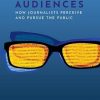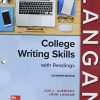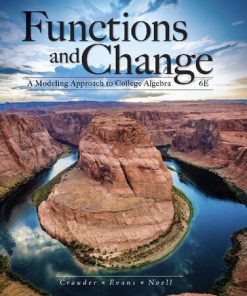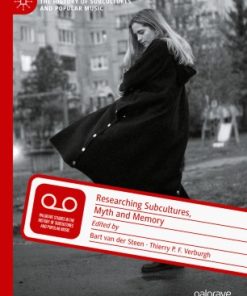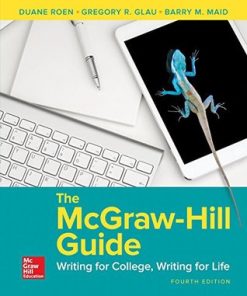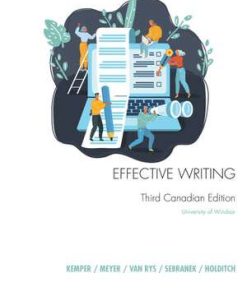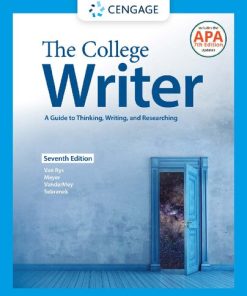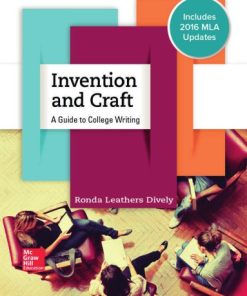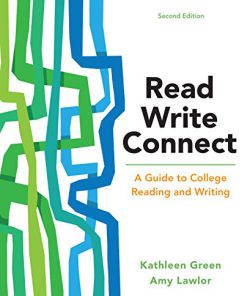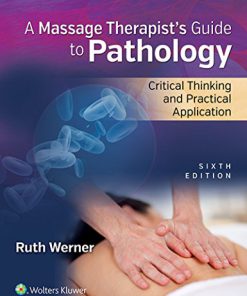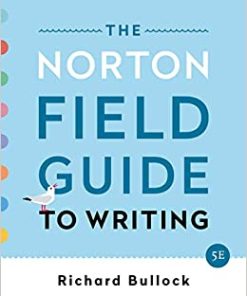(Ebook PDF) The College Writer A Guide to Thinking, Writing, and Researching 6th Edition by John Van Rys 9798214339931 full chapters
$50.00 Original price was: $50.00.$25.00Current price is: $25.00.
The College Writer: A Guide to Thinking, Writing, and Researching 6th Edition by John Van Rys – Ebook PDF Instant Download/DeliveryISBN: 9798214339931
Full download The College Writer: A Guide to Thinking, Writing, and Researching 6th Edition after payment.
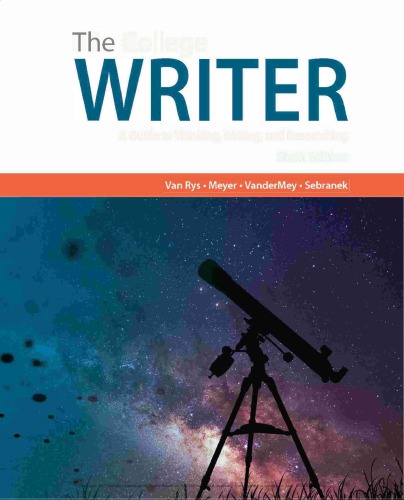
Product details:
ISBN-13 : 9798214339931
Author : John Van Rys
Combining streamlined instruction in the writing process with an accessible style, THE COLLEGE WRITER is your all-in-one writing resource. Throughout the text, samples of student and professional writing in different disciplines and from different career paths highlight important features of effective writing and help you craft papers for all of your courses. A research guide, including the most current MLA and APA documentation guidelines, helps you meet all the expectations of your academic projects. Learning Outcomes in each chapter show you the key concepts you’ll be expected to know.
The College Writer: A Guide to Thinking, Writing, and Researching 6th Table of contents:
I. Rhetoric: A College Student’s Guide to Writing
Chapter 1. Critical Thinking Through Reading, Viewing, and Writing
Critical Thinking Through Reading
Read Actively
Map the Text
Outline the Text
Evaluate the Text
Responding to a Text
Guidelines for Response Writing
Summarizing a Text
Guidelines for Summary Writing
Critical Thinking Through Viewing
Actively View Images
View an Image
Interpreting an Image
Interpret an Image
Evaluating an Image
Consider the Purpose
Evaluate the Quality
Determine the Value
Critical Thinking Through Writing
Develop Sound Critical-Thinking Habits
Ask Probing Questions
Practice Inductive and Deductive Logic
Practicing Modes of Thinking in Your Writing
Think by Using Analysis
Think by Using Synthesis
Think by Using Evaluation
Think by Using Application
Critical Thinking and Writing: Applications
Chapter 2. Beginning the Writing Process
The Writing Process: From Start to Finish
Consider the Writing Process
Adapt the Process to Your Project
Understanding the Rhetorical Situation
Think of Your Role as the Writer
Understand Your Subject
Understand Your Purpose
Understand Your Audience
Understand the Medium (Form)
Think About the Context
Aiming for Writing Excellence
Common Traits of College Writing
Common Traits in Action
Understanding the Assignment
Read the Assignment
Relate the Assignment to the Goals of the Course
Relate the Assignment to Other Assignments
Relate the Assignment to Your Own Interests
Reflect on the Assignment
Developing a Topic
Limit the Subject Area
Conduct Your Search
Explore Possible Topics
Freewrite to Discover and Develop a Topic
Researching Your Topic
Find Out What You Already Know
Ask Questions
Identify Possible Sources
Track Sources
Critical Thinking and Writing: Applications
Chapter 3. Planning
Revisiting the Rhetorical Situation
Rhetorical Checklist
Forming Your Thesis Statement
Find a Focus
State Your Thesis
Refine Your Thesis
Using a Thesis to Pattern Your Writing
Let Your Thesis Guide You
Developing a Plan or an Outline
Quick Lists
Topic Outline
Sentence Outline
Writing Blueprints
Graphic Organizers
Critical Thinking and Writing: Applications
Chapter 4. Drafting
Reconsider the Rhetorical Situation
Think About Your Role
Focus On Your Subject
Reconsider Your Purpose
Reconsider Your Audience
Review the Form and Context
Basic Essay Structure: Major Moves
Opening your Draft
Engage Your Reader
Establish Your Direction
Get to the Point
Developing the Middle
Advance your Thesis
Test Your Ideas
Build a Coherent Structure
Make Writing Moves
Ending Your Draft
Reassert the Main Point
Urge the Reader
Complete and Unify Your Message
Critical Thinking and Writing: Applications
Chapter 5. Revising
Consider Whole-Paper Issues
Revisit the Rhetorical Situation
Consider Your Overall Approach
Revising Your First Draft
Prepare to Revise
Think Globally
Revising for Ideas and Organization
Examine Your Ideas
Examine Your Organization
Revising for Voice and Style
Check the Level of Commitment
Check the Intensity of Your Writing
Develop an Academic Style
Know When to Use the Passive Voice
Addressing Paragraph Issues
Remember the Basics
Keep the Purpose in Mind
Check for Unity
Check for Coherence
Check for Completeness
Revising Collaboratively
Know Your Role
Provide Appropriate Feedback
Respond According to a Plan
Using the Writing Center
Critical Thinking and Writing: Applications
Chapter 6. Editing and Proofreading
Strategies for Polishing Your Writing
Review the Overall Style of your Writing
Use Tools and Methods That Work
Combining Sentences
Edit Short, Simplistic Sentences
Expanding Sentences
Use Cumulative Sentences
Expand with Details
Checking for Sentence Style
Avoid These Sentence Problems
Review Your Writing for Sentence Variety
Vary Sentence Structures
Use Parallel Structure
Avoid Weak Constructions
Eliminate Wordiness
Avoiding Vague, Weak, and Biased Words
Substitute Specific Words
Replace Jargon and Clichés
Strive for Plain English
Change Biased Words
Proofreading your Writing
Review Punctuation and Mechanics
Look for Usage and Grammar Errors
Check for Spelling Errors
Check the Writing for Form and Presentation
Critical Thinking and Writing: Applications
Chapter 7. Submitting Writing and Creating Portfolios
Formatting Your Writing
Strive for Clarity in Page Design
Submitting Writing and Creating Portfolios
Consider Potential Audiences
Select Appropriate Submission Methods
Use a Writing Portfolio
Digest Feedback from Readers
Critical Thinking and Writing: Applications
Chapter 8. One Writer’s Process
Angela’s Assignment and Response
Angela Examined the Assignment
Angela Explored and Narrowed Her Assignment
Angela’s Planning
Angela Focused Her Topic
Angela Researched the Topic
Angela Decided How to Organize Her Writing
Angela’s First Draft
Angela Kept a Working Bibliography
Angela’s First Revision
Angela’s Second Revision
Angela’s Edited Draft
Angela’s Proofread Draft
Angela’s Finished Essay
Critical Thinking and Writing: Applications
Traits of College Writing: A Checklist
II. Reader: Strategies and Samples
Chapter 9. Forms of College Writing
Three Curricular Divisions
Humanities
Social Sciences
Natural and Applied Sciences
Writing in the Humanities
The Purpose of Inquiry
Forms of Humanities Writing
Humanities Research Methods
Writing in the Social Sciences
The Purpose of Inquiry
Forms of Social-Science Writing
Social-Science Research Methods
Writing in the Natural and Applied Sciences
The Purpose of Inquiry
Forms of Natural-Science Writing
Natural-Science Research Methods
The Rhetorical Modes
The Modes as Thinking Framework
The Modes at Work
Critical Thinking and Writing: Applications
Chapter 10. Narration, Description, and Reflection
Strategies for Personal Essays
The Rhetorical Situation
Principles of Narration
Principles of Description
Principles of Reflection
Principles of Organization
Reading Personal Writing
Brief Narratives: Anecdotes
Anecdote Introducing a Topic
Anecdote Illustrating a Process
Anecdote Illustrating a Trait
Sample Personal Essays
Exploring a Tense Situation
Narrating an Encounter
Examining a Failed Institution
Reflecting on a Cultural Trend
Seeking and Finding
Writing Guidelines
Critical Thinking and Writing: Applications
Chapter 11. Definition
Strategies for Definition Essays
The Rhetorical Situation
Principles of Definition Writing
Reading Definition Writing
Sample Definition Essays
Defining Key Terms Within an Essay
Defining an Academic Discipline
Distinguishing Related Terms
Illustrating a Term
Defining a Stage of Life
Defining a Personal Trait
Writing Guidelines
Critical Thinking and Writing: Applications
Chapter 12. Classification
Strategies for Classification Essays
The Rhetorical Situation
Principles of Classification Writing
Reading Classification Writing
Sample Classification Essays
Analyzing Forms of Music
Analyzing Weight Lifters
Analyzing Rhetorical Positions on Climate Change
Analyzing How Readers Read
Writing Guidelines
Critical Thinking and Writing: Applications
Chapter 13. Process
Strategies for Process Writing
The Rhetorical Situation
Principles of Process Writing
Reading Process Writing
Sample Process Essays
Analyzing an Illness
Analyzing Medical Procedures
Describing a Pre-Burial Procedure
Analyzing a Policy
Writing Guidelines
Critical Thinking and Writing: Applications
Chapter 14. Comparison and Contrast
Strategies for Comparison-Contrast Essays
The Rhetorical Situation
Principles of Comparison-Contrast Writing
Reading Comparison-Contrast Writing
Sample Comparison-Contrast Essays
Analyzing Two Cultures
Analyzing Human Compassion
Analyzing a Journey
Analyzing Internet Bullying
Writing Guidelines
Critical Thinking and Writing: Applications
Chapter 15. Cause and Effect
Strategies for Cause-Effect Essays
The Rhetorical Situation
Principles of Cause-Effect Writing
Reading Cause-Effect Writing
Sample Cause-Effect Essays
Analyzing a Cognitive Disorder
Analyzing a Trend
Analyzing Fear of Sharks
Analyzing the Effects of Technology
Analyzing an Analytical Strategy
Writing Guidelines
Critical Thinking and Writing: Applications
Chapter 16. Reading Literature: A Case Study in Analysis
Strategies for Analyzing Literature and the Arts
The Rhetorical Situation
Principles of Literary-Analysis Writing
Reading Literary-Analysis Writing
Approaches to Literary Criticism
Analyzing a Poem
Analysis of Kenyon’s Poem
A Poem to Analyze
Analyzing a Short Story
Analysis of a Short Story
Analyzing a Film
Literary Terms
Poetry Terms
Writing Guidelines
Critical Thinking and Writing: Applications
Chapter 17. Strategies for Argumentation and Persuasion
Understanding Arguments
Sample Essay of Argumentation
Structuring Arguments
Understand Toulmin Argumentation
Understand Rogerian Argumentation
Choose an Approach
Engaging the Opposition
Make Concessions
Develop Rebuttals
Consolidate Your Claim
Arguing Through Appeals
Appeal to Ethos
Appeal to Pathos
Appeal to Logos
Making and Qualifying Claims
Distinguish Claims From Facts and Opinions
Distinguish Three Types of Claims
Develop a Supportable Claim
Supporting Your Claims
Gather Evidence
Use Evidence
Identifying Logical Fallacies
Distorting the Issue
Sabotaging the Argument
Drawing Faulty Conclusions from the Evidence
Misusing Evidence
Misusing Language
Identifying Fallacies in Others’ Arguments
Critical Thinking and Writing: Applications
Chapter 18. Arguing for Positions, Actions, and Solutions
Strategies for Argumentative Writing
The Rhetorical Situation
Principles: Taking a Stand
Principles: Calling for Action
Principles: Proposing a Solution
Reading Persuasive Writing
Sample Argumentative Essays
Taking a Stand on Female Self-Esteem
Solving the Problem of E-Waste
Taking a Considered Position on Prison
Taking a Position on a Campus Statue
Addressing AIDS in Africa
Taking Action on Academic Freedom
Taking a Position on Fatherhood
Writing Guidelines
Critical Thinking and Writing: Applications
III. Research and Writing
Chapter 19. Getting Started: From Planning Research to Evaluating Sources
Papers with Documented Research: Quick Guide
The Research Process: A Flowchart
Getting Focused
Establish a Narrow, Manageable Topic
Brainstorm Research Questions
Develop a Working Thesis
Understanding Primary, Secondary, and Tertiary Sources
Primary Sources
Secondary Sources
Tertiary Sources
Developing a Research Plan
Choose Research Methods
Get Organized to Do Research
Writing a Research Proposal
Understand the Parts of a Research Proposal
Exploring Information Resources and Sites
Consider Different Information Resources
Consider Different Information Sites
Conducting Effective Keyword Searches
Choose Keywords Carefully
Use Keyword Strategies
Engaging and Evaluating Sources
Engage Your Sources
Rate Source Reliability and Depth
Evaluate Print and Online Sources
Creating a Working Bibliography
Select an Efficient Approach for Your Project
Annotate the Source
Developing a Note-Taking System
Develop Note-Taking Strategies
Employ Note-Taking Systems
Summarizing, Paraphrasing, and Quoting Source Material
Summarize Useful Passages
Paraphrase Key Passages
Quote Crucial Phrases, Sentences, and Passages
Avoiding Unintentional Plagiarism
Practice the Principles of Ethical Research
Critical Thinking and Writing: Applications
Chapter 20. Conducting Research: Primary, Library, Web
Planning Primary Research
Methods of Primary Research
Principles for Doing Primary Research
Conducting Surveys
Analyzing Texts, Documents, Records, and Artifacts
Choose Evidence Close to Your Topic
Put the Document or Artifact in Context
Frame Your Examination with Questions
Draw Coherent Conclusions About Meaning
Conducting Interviews
Sample Interview Note-Taking Sheet
Making Observations
Prepare to Observe
Conduct Your Observations
Make Sense of Your Observations
Becoming Familiar with the Library
Searching the Catalog
Locating Resources by Call Numbers
Classification Systems
Using Books in Research
Approach the Book Systematically
Using Reference Resources
Check Reference Works That Supply Information
Check Reference Works That Are Research Tools
Finding Articles Via Databases
Search Online Databases
Generate Citation Lists of Promising Articles
Study Citations and Capture Identifying Information
Find and Retrieve the Full Text of the Article
Understanding Internet Basics
Using a Subject Guide/Directory
Using Search and Metasearch
Using Search Engines as Research Tools
Use Search Engines Well
Understanding the Uses and Limits of Wikipedia
Know Wikipedia’s Strengths
Understand Wikipedia’s Standards for Truth
Know Wikipedia’s Weaknesses
Use Wikipedia Cautiously
Evaluating Online Sources
Assignment Restrictions
Author/Organization
Balance or Bias
Quality of Information
Quality of Writing and Design
Evaluation Checklist
Sample Evaluations
Critical Thinking and Writing: Applications
Chapter 21. Building Credibility: Avoiding Plagiarism
Developing Credibility through Source Use
Writing with Poor Use of Sources
Writing with Strong Use of Sources
Recognizing Plagiarism
What Is Plagiarism?
What Does Plagiarism Look Like?
Understanding Why Plagiarism Is Serious
Academic Dishonesty
Theft from the Academic Community
Present and Future Harm
Avoiding Plagiarism
Avoiding Other Source Abuses
Sample Source Abuses
Related Academic Offenses
Critical Thinking and Writing: Applications
Chapter 22. Drafting Papers with Documented Research
Reviewing Your Findings
Conduct Q & A
Deepen Your Thinking on the Topic
Imagine Your Paper
Sharpening Your Working Thesis
Deepen Your Thesis
Question Your Thesis
Considering Methods of Organization
Organizational Practices That Consider Sources
Traditional Organizational Patterns
Considering Drafting Strategies
Choose a Drafting Method
Respect Your Sources While Drafting
Reason with the Evidence
Using Source Material in Your Writing
Integrate Source Material Carefully
Effectively Document Your Sources
Mark Changes to Quotations
Sample Research Paper: A Humanities Essay
Sample Research Paper: Science IMRAD Report
Critical Thinking and Writing: Applications
Chapter 23. MLA Style
MLA Documentation: Quick Guide
In-Text Citation: The Basics
Works Cited: Nine Core Elements
Guidelines for In-Text Citations
Citations for Regular Sources
Citations for Sources without Traditional Authorship and/or Pagination
Sample In-Text Citations
One Author: A Complete Work
Guidelines for Works-Cited Entries
Works-Cited Template
Works-Cited Components
Optional Elements
Sample Works-Cited Entries
Books
Periodical Articles
Interviews and Personal Correspondence
Multimedia Works
Government Publications, Reference Works, and Other Documents
MLA Format Guidelines
MLA Format at a Glance
Whole-Paper Format and Printing Issues
Typographical Issues
Page-Layout Issues
Sample MLA Paper
Sample Paper: Format, In-Text Citation, and Works-Cited List
Critical Thinking and Writing: Applications
Chapter 24. APA Style
APA Documentation: Quick Guide
In-Text Citation: The Basics
References: The Basics
Guidelines for In-Text Citations
The Form of an Entry
Points to Remember
Sample In-Text Citations
Guidelines for APA References
Sample Reference Entries
Books and Other Documents
Print Periodical Articles
Online Sources
Other Sources (Primary, Personal, and Multimedia)
APA Format Guidelines
APA Guidelines on Bias-Free Language
Sample APA Paper
Sample Title Page
Sample Abstract
Critical Thinking and Writing: Applications
IV. Handbook
Chapter 25. Understanding Grammar
Noun
Classes of Nouns
Forms of Nouns
Grammar Exercises: Nouns
Pronoun
Antecedents
Classes of Pronouns
Forms of Personal Pronouns
Grammar Exercises: Pronouns
Verb
Classes of Verbs
Forms of Verbs
Verbals
Irregular Verbs
Grammar Exercises: Verbs
Adjective
Proper Adjectives
Adverb
Types of Adverbs
Preposition
Prepositional Phrases
Conjunction
Coordinating Conjunctions
Interjection
Grammar Exercises: Adjectives, Adverbs, Prepositions, Conjunctions, and Injections
Chapter 26. Constructing Sentences
Using Subjects and Predicates
The Subject
The Predicate (Verb)
Constructing Sentences Exercises: Subjects and Predicates
Using Phrases
Types of Phrases
Using Clauses
Independent/Dependent Clauses
Types of Clauses
Using Sentence Variety
Kinds of Sentences
Structure of Sentences
Constructing Sentences Exercises: Phrases, Clauses, and Sentence Variety
People also search for The College Writer: A Guide to Thinking, Writing, and Researching 6th:
the college writer 5th edition pdf
the college writer 6th edition pdf
thinking rhetorically a guide to college writing pdf
a short guide to college writing pdf
the thinking student’s guide to college
Tags:
The College Writer,A Guide,Thinking,Writing,Researching,John Van Rys
You may also like…
Mathematics - Algebra
Functions and Change: A Modeling Approach to College Algebra 6th Edition by Bruce Crauder
dictionaries & phrasebooks
The McGraw-Hill Guide: Writing for College, Writing For Life
Education Studies & Teaching - Educational Theory
Custom eBook: Effective Writing for University of Windsor Third Edition
Languages - Rhetoric
The College Writer: A Guide to Thinking, Writing, and Researching 7th Edition John Van Rys
Reference - Writing
Invention and Craft: A Guide to College Writing 1st Edition Ronda Leathers Dively
Uncategorized
Uncategorized


